IT 210 Business Systems Analysis: Milestone One Project Report
VerifiedAdded on 2022/09/02
|14
|1956
|28
Project
AI Summary
This project, part of the IT 210 Business Systems Analysis course, presents a comprehensive analysis of a brick-and-mortar business specializing in designer clothing, handbags, and shoes. The project identifies the challenges faced by the business, including limited customer reach and the absence of a robust reporting system. It proposes two key technologies: Big Data and knowledge management, and wireless, mobile computing, and mobile commerce. The project outlines the business requirements, objectives, and a project description focusing on technological integration. It explores the technological requirements, analyzes competitors' use of these technologies, and details the benefits and solutions offered by each. Recommendations are provided, emphasizing the benefits of mobile computing for expanding customer reach. Security considerations, including features, third-party vendor considerations, and internal safeguards, are also addressed. The project includes references to support the analysis and recommendations.
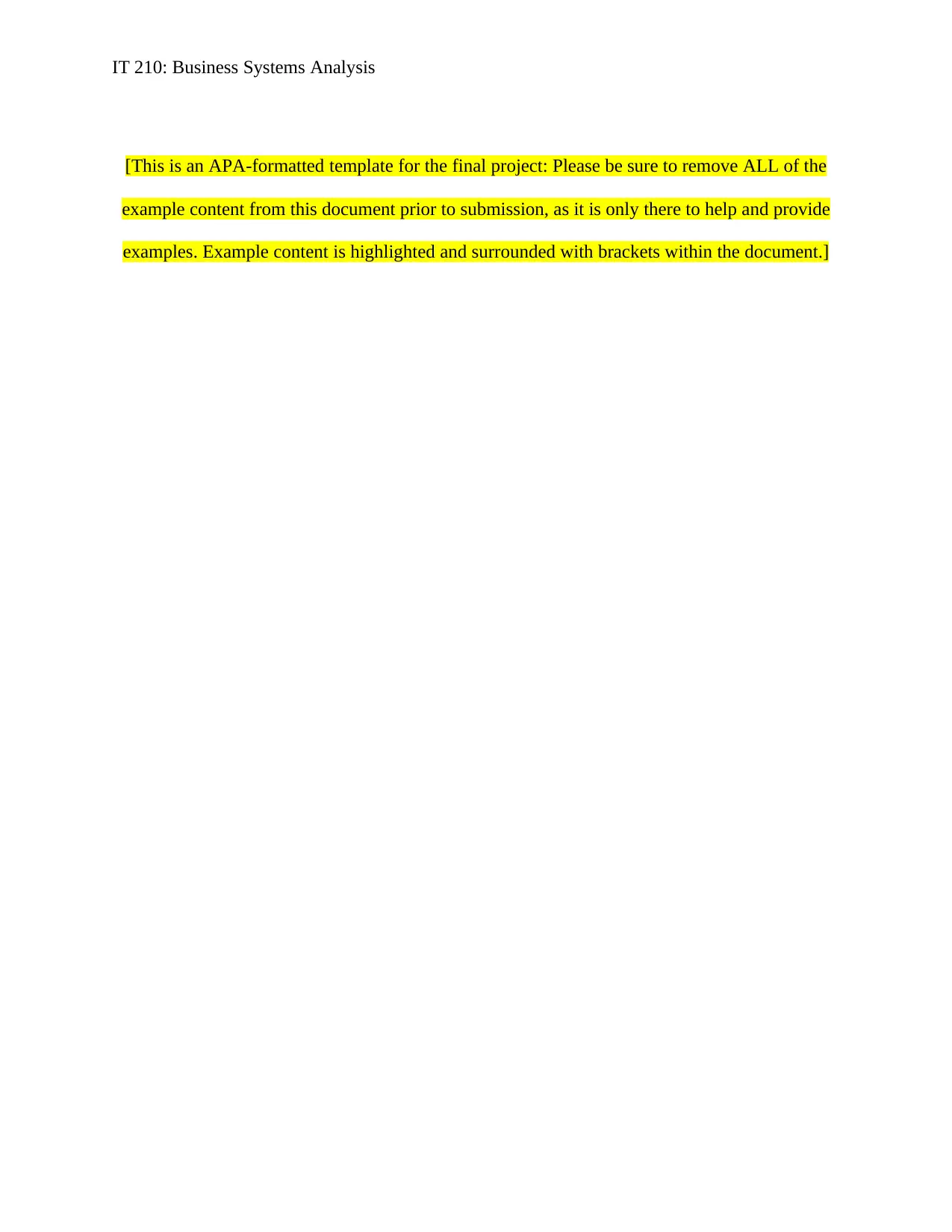
IT 210: Business Systems Analysis
[This is an APA-formatted template for the final project: Please be sure to remove ALL of the
example content from this document prior to submission, as it is only there to help and provide
examples. Example content is highlighted and surrounded with brackets within the document.]
[This is an APA-formatted template for the final project: Please be sure to remove ALL of the
example content from this document prior to submission, as it is only there to help and provide
examples. Example content is highlighted and surrounded with brackets within the document.]
Paraphrase This Document
Need a fresh take? Get an instant paraphrase of this document with our AI Paraphraser
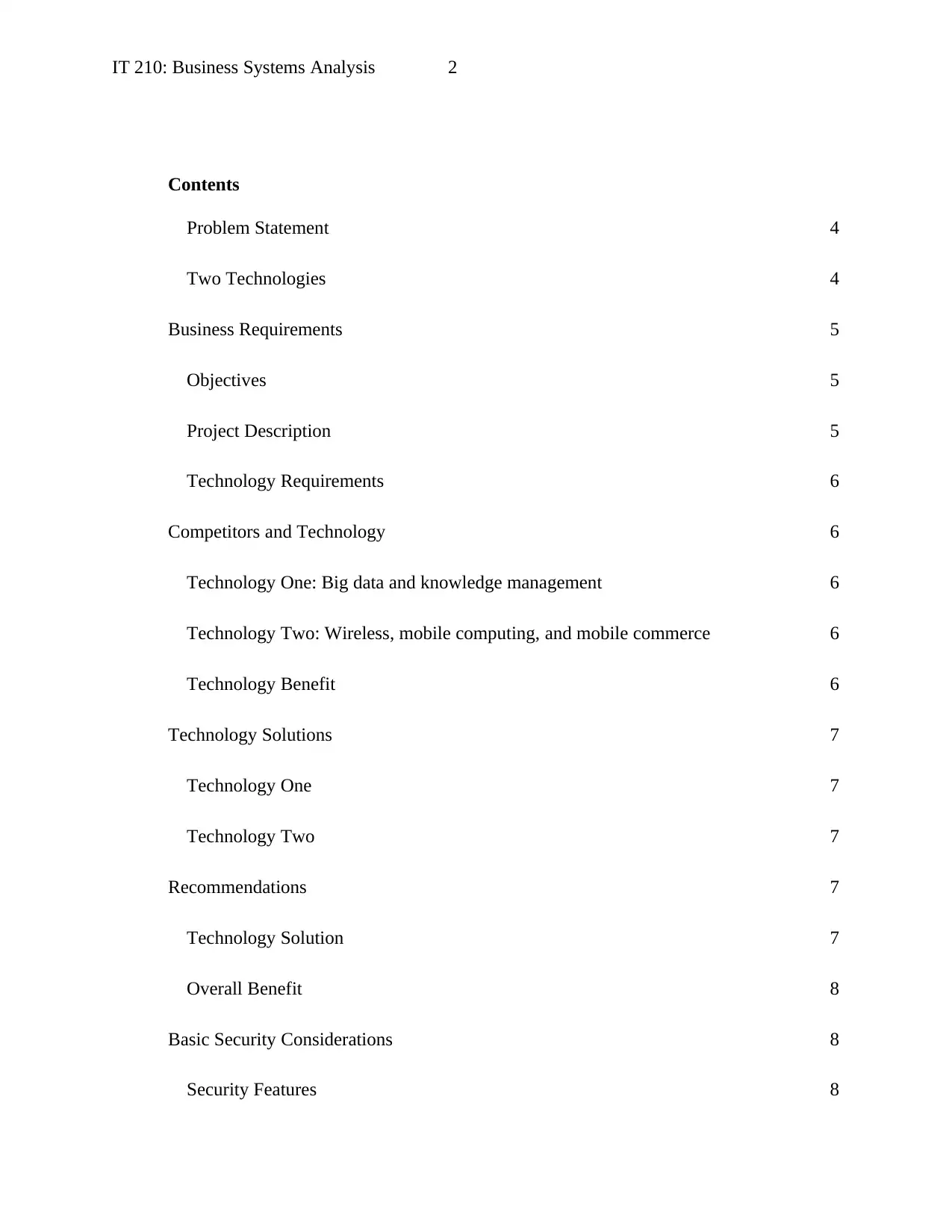
IT 210: Business Systems Analysis 2
Contents
Problem Statement 4
Two Technologies 4
Business Requirements 5
Objectives 5
Project Description 5
Technology Requirements 6
Competitors and Technology 6
Technology One: Big data and knowledge management 6
Technology Two: Wireless, mobile computing, and mobile commerce 6
Technology Benefit 6
Technology Solutions 7
Technology One 7
Technology Two 7
Recommendations 7
Technology Solution 7
Overall Benefit 8
Basic Security Considerations 8
Security Features 8
Contents
Problem Statement 4
Two Technologies 4
Business Requirements 5
Objectives 5
Project Description 5
Technology Requirements 6
Competitors and Technology 6
Technology One: Big data and knowledge management 6
Technology Two: Wireless, mobile computing, and mobile commerce 6
Technology Benefit 6
Technology Solutions 7
Technology One 7
Technology Two 7
Recommendations 7
Technology Solution 7
Overall Benefit 8
Basic Security Considerations 8
Security Features 8
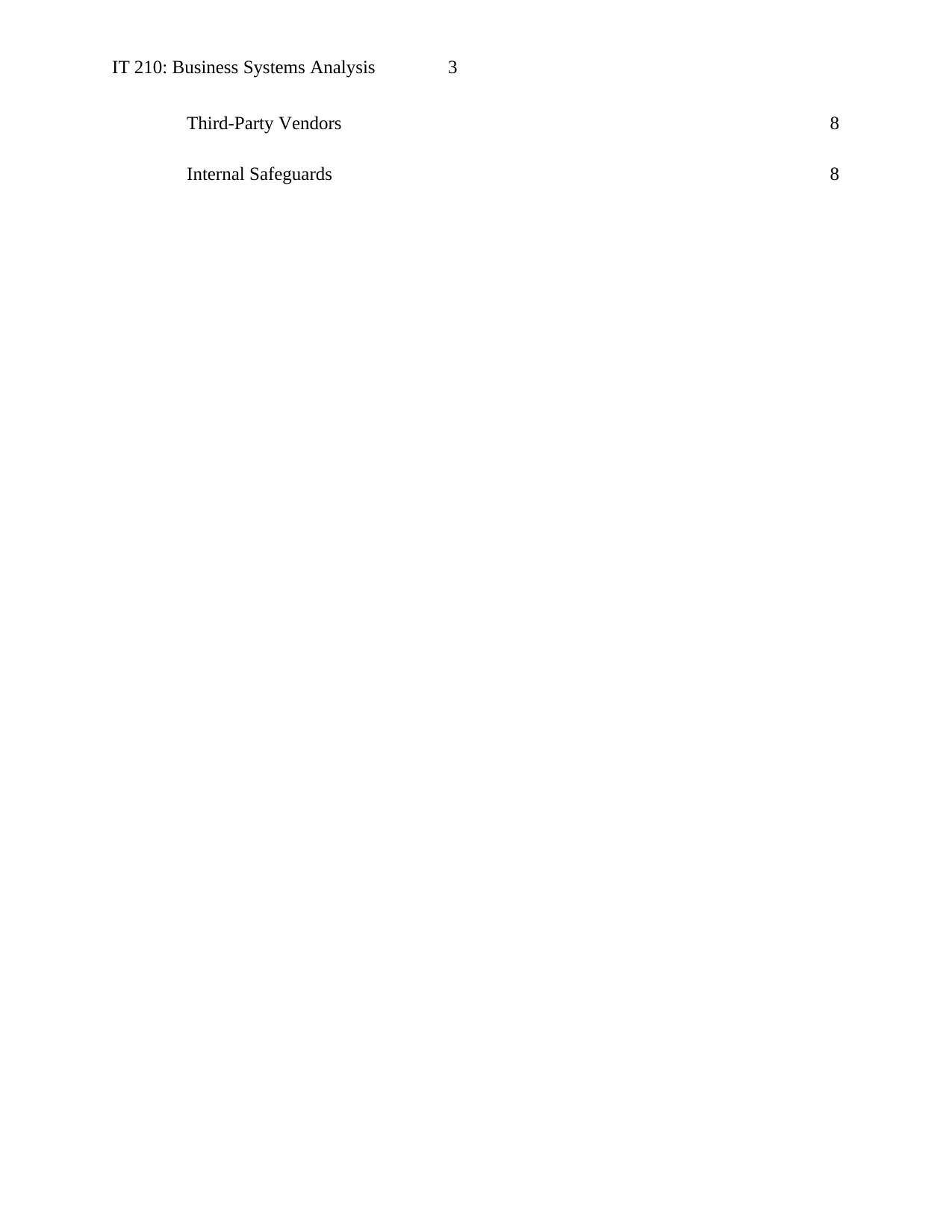
IT 210: Business Systems Analysis 3
Third-Party Vendors 8
Internal Safeguards 8
Third-Party Vendors 8
Internal Safeguards 8
⊘ This is a preview!⊘
Do you want full access?
Subscribe today to unlock all pages.

Trusted by 1+ million students worldwide
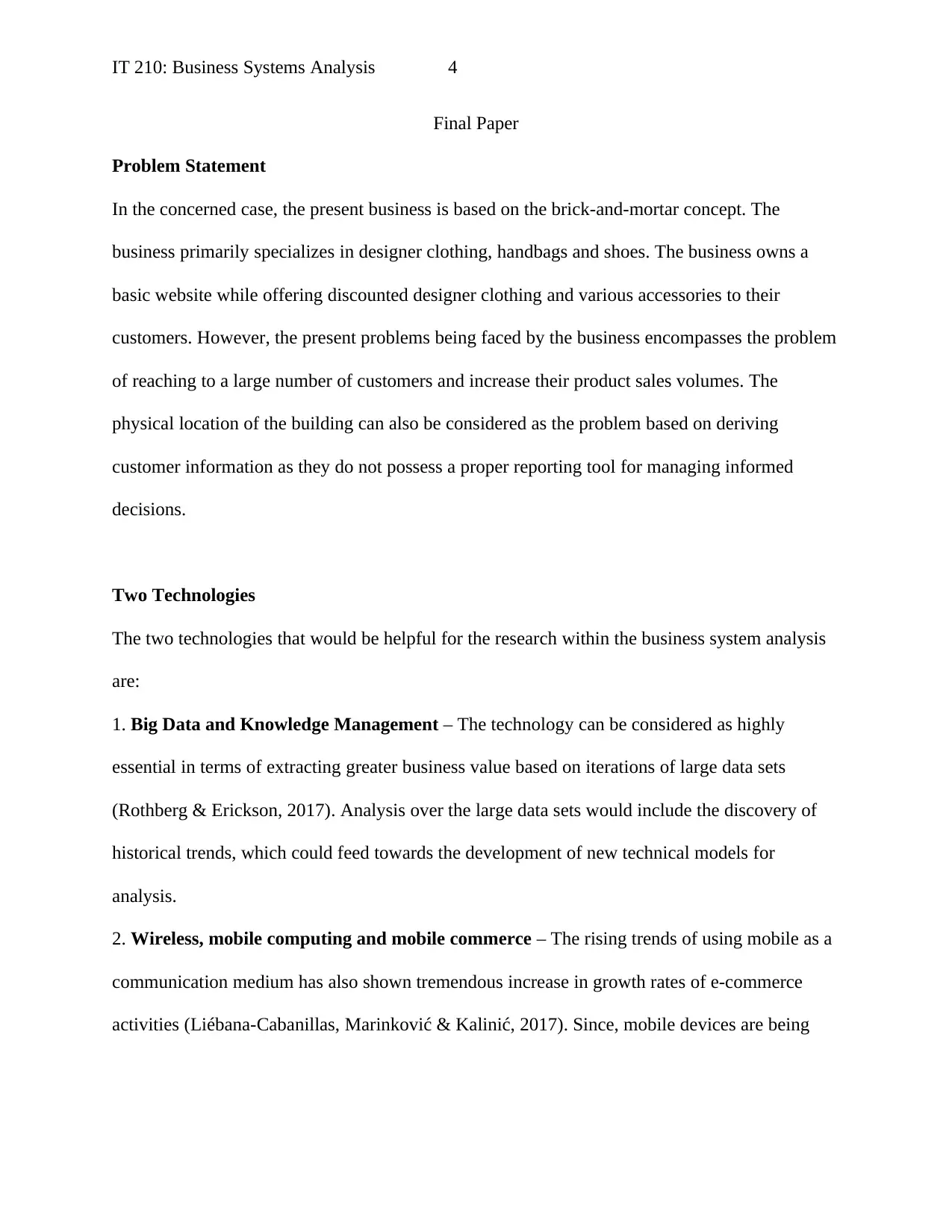
IT 210: Business Systems Analysis 4
Final Paper
Problem Statement
In the concerned case, the present business is based on the brick-and-mortar concept. The
business primarily specializes in designer clothing, handbags and shoes. The business owns a
basic website while offering discounted designer clothing and various accessories to their
customers. However, the present problems being faced by the business encompasses the problem
of reaching to a large number of customers and increase their product sales volumes. The
physical location of the building can also be considered as the problem based on deriving
customer information as they do not possess a proper reporting tool for managing informed
decisions.
Two Technologies
The two technologies that would be helpful for the research within the business system analysis
are:
1. Big Data and Knowledge Management – The technology can be considered as highly
essential in terms of extracting greater business value based on iterations of large data sets
(Rothberg & Erickson, 2017). Analysis over the large data sets would include the discovery of
historical trends, which could feed towards the development of new technical models for
analysis.
2. Wireless, mobile computing and mobile commerce – The rising trends of using mobile as a
communication medium has also shown tremendous increase in growth rates of e-commerce
activities (Liébana-Cabanillas, Marinković & Kalinić, 2017). Since, mobile devices are being
Final Paper
Problem Statement
In the concerned case, the present business is based on the brick-and-mortar concept. The
business primarily specializes in designer clothing, handbags and shoes. The business owns a
basic website while offering discounted designer clothing and various accessories to their
customers. However, the present problems being faced by the business encompasses the problem
of reaching to a large number of customers and increase their product sales volumes. The
physical location of the building can also be considered as the problem based on deriving
customer information as they do not possess a proper reporting tool for managing informed
decisions.
Two Technologies
The two technologies that would be helpful for the research within the business system analysis
are:
1. Big Data and Knowledge Management – The technology can be considered as highly
essential in terms of extracting greater business value based on iterations of large data sets
(Rothberg & Erickson, 2017). Analysis over the large data sets would include the discovery of
historical trends, which could feed towards the development of new technical models for
analysis.
2. Wireless, mobile computing and mobile commerce – The rising trends of using mobile as a
communication medium has also shown tremendous increase in growth rates of e-commerce
activities (Liébana-Cabanillas, Marinković & Kalinić, 2017). Since, mobile devices are being
Paraphrase This Document
Need a fresh take? Get an instant paraphrase of this document with our AI Paraphraser
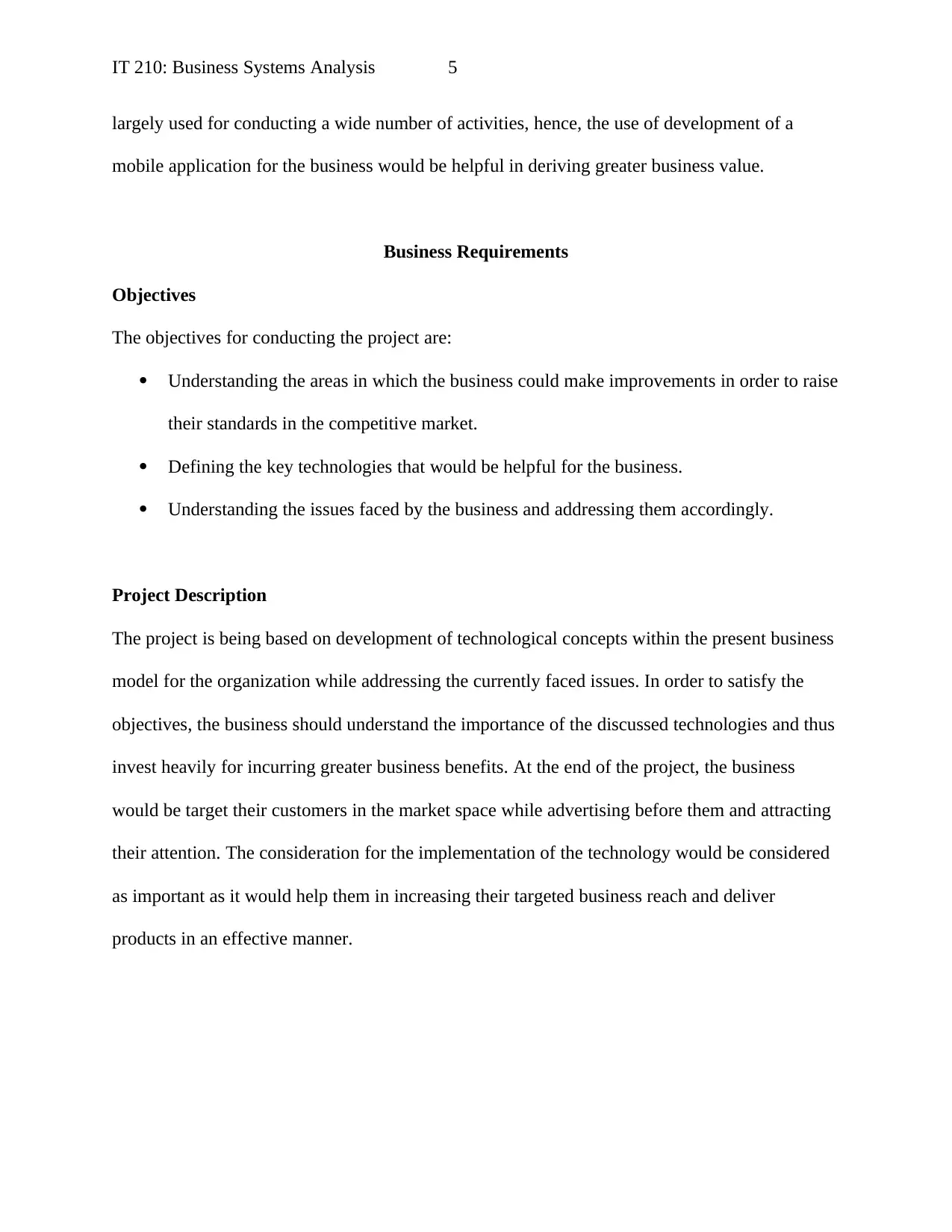
IT 210: Business Systems Analysis 5
largely used for conducting a wide number of activities, hence, the use of development of a
mobile application for the business would be helpful in deriving greater business value.
Business Requirements
Objectives
The objectives for conducting the project are:
Understanding the areas in which the business could make improvements in order to raise
their standards in the competitive market.
Defining the key technologies that would be helpful for the business.
Understanding the issues faced by the business and addressing them accordingly.
Project Description
The project is being based on development of technological concepts within the present business
model for the organization while addressing the currently faced issues. In order to satisfy the
objectives, the business should understand the importance of the discussed technologies and thus
invest heavily for incurring greater business benefits. At the end of the project, the business
would be target their customers in the market space while advertising before them and attracting
their attention. The consideration for the implementation of the technology would be considered
as important as it would help them in increasing their targeted business reach and deliver
products in an effective manner.
largely used for conducting a wide number of activities, hence, the use of development of a
mobile application for the business would be helpful in deriving greater business value.
Business Requirements
Objectives
The objectives for conducting the project are:
Understanding the areas in which the business could make improvements in order to raise
their standards in the competitive market.
Defining the key technologies that would be helpful for the business.
Understanding the issues faced by the business and addressing them accordingly.
Project Description
The project is being based on development of technological concepts within the present business
model for the organization while addressing the currently faced issues. In order to satisfy the
objectives, the business should understand the importance of the discussed technologies and thus
invest heavily for incurring greater business benefits. At the end of the project, the business
would be target their customers in the market space while advertising before them and attracting
their attention. The consideration for the implementation of the technology would be considered
as important as it would help them in increasing their targeted business reach and deliver
products in an effective manner.
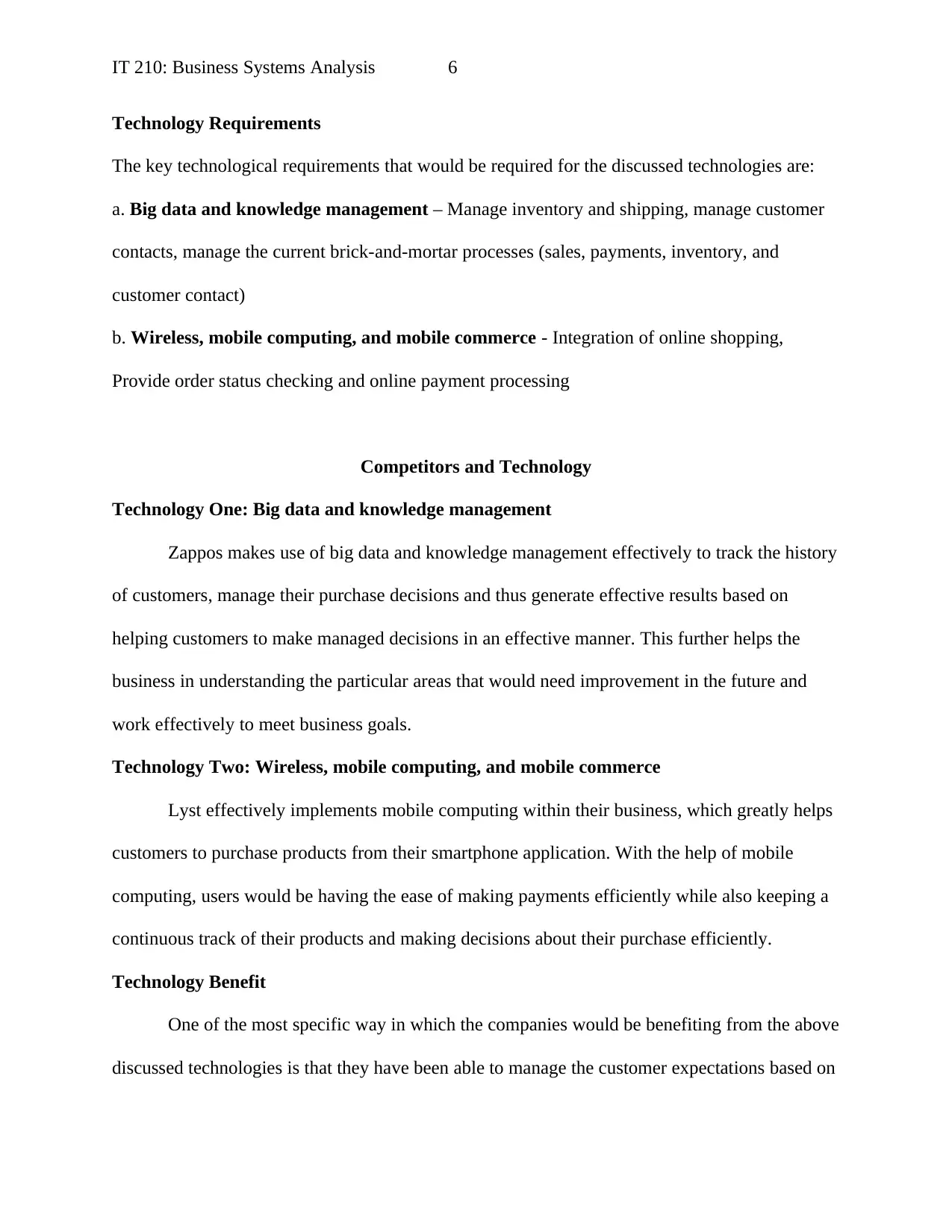
IT 210: Business Systems Analysis 6
Technology Requirements
The key technological requirements that would be required for the discussed technologies are:
a. Big data and knowledge management – Manage inventory and shipping, manage customer
contacts, manage the current brick-and-mortar processes (sales, payments, inventory, and
customer contact)
b. Wireless, mobile computing, and mobile commerce - Integration of online shopping,
Provide order status checking and online payment processing
Competitors and Technology
Technology One: Big data and knowledge management
Zappos makes use of big data and knowledge management effectively to track the history
of customers, manage their purchase decisions and thus generate effective results based on
helping customers to make managed decisions in an effective manner. This further helps the
business in understanding the particular areas that would need improvement in the future and
work effectively to meet business goals.
Technology Two: Wireless, mobile computing, and mobile commerce
Lyst effectively implements mobile computing within their business, which greatly helps
customers to purchase products from their smartphone application. With the help of mobile
computing, users would be having the ease of making payments efficiently while also keeping a
continuous track of their products and making decisions about their purchase efficiently.
Technology Benefit
One of the most specific way in which the companies would be benefiting from the above
discussed technologies is that they have been able to manage the customer expectations based on
Technology Requirements
The key technological requirements that would be required for the discussed technologies are:
a. Big data and knowledge management – Manage inventory and shipping, manage customer
contacts, manage the current brick-and-mortar processes (sales, payments, inventory, and
customer contact)
b. Wireless, mobile computing, and mobile commerce - Integration of online shopping,
Provide order status checking and online payment processing
Competitors and Technology
Technology One: Big data and knowledge management
Zappos makes use of big data and knowledge management effectively to track the history
of customers, manage their purchase decisions and thus generate effective results based on
helping customers to make managed decisions in an effective manner. This further helps the
business in understanding the particular areas that would need improvement in the future and
work effectively to meet business goals.
Technology Two: Wireless, mobile computing, and mobile commerce
Lyst effectively implements mobile computing within their business, which greatly helps
customers to purchase products from their smartphone application. With the help of mobile
computing, users would be having the ease of making payments efficiently while also keeping a
continuous track of their products and making decisions about their purchase efficiently.
Technology Benefit
One of the most specific way in which the companies would be benefiting from the above
discussed technologies is that they have been able to manage the customer expectations based on
⊘ This is a preview!⊘
Do you want full access?
Subscribe today to unlock all pages.

Trusted by 1+ million students worldwide
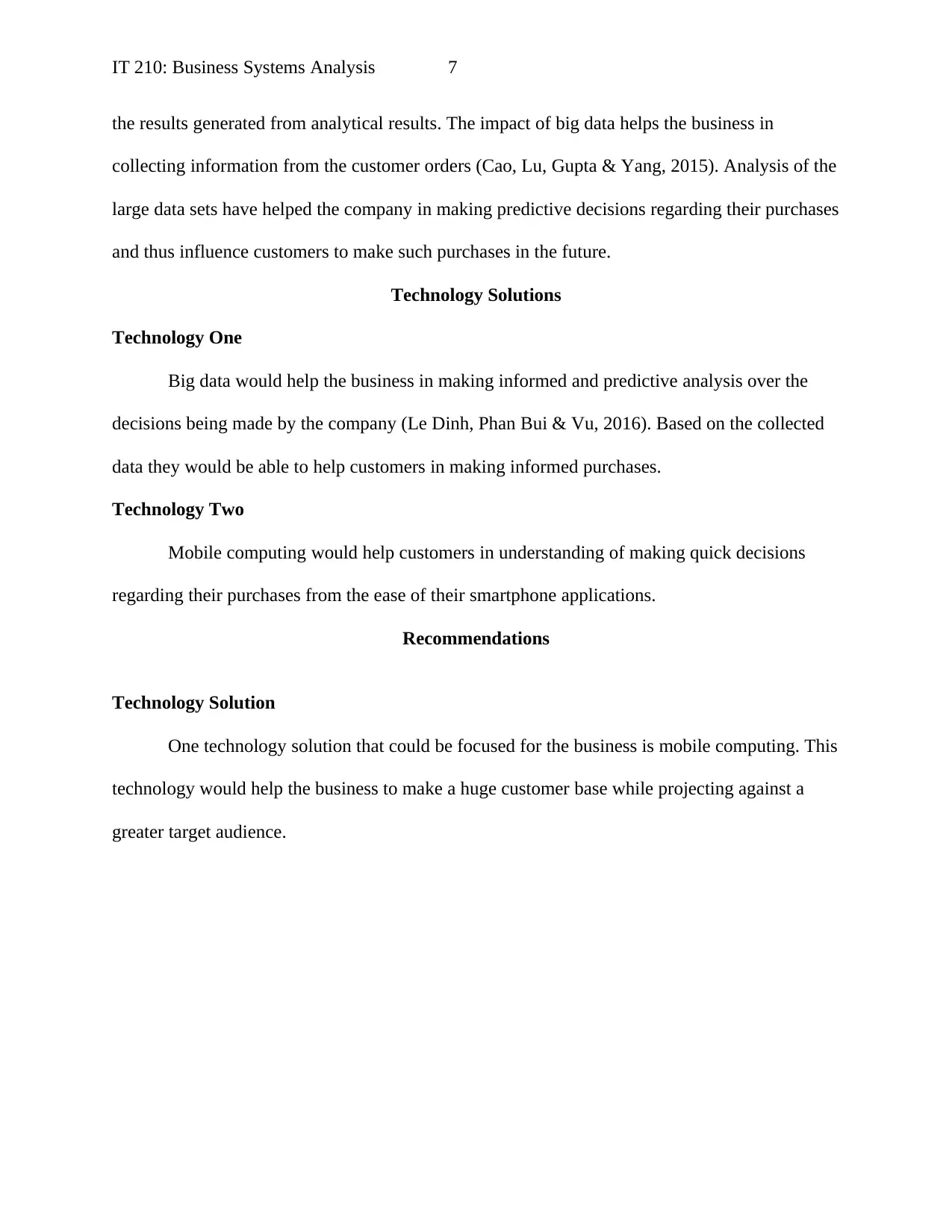
IT 210: Business Systems Analysis 7
the results generated from analytical results. The impact of big data helps the business in
collecting information from the customer orders (Cao, Lu, Gupta & Yang, 2015). Analysis of the
large data sets have helped the company in making predictive decisions regarding their purchases
and thus influence customers to make such purchases in the future.
Technology Solutions
Technology One
Big data would help the business in making informed and predictive analysis over the
decisions being made by the company (Le Dinh, Phan Bui & Vu, 2016). Based on the collected
data they would be able to help customers in making informed purchases.
Technology Two
Mobile computing would help customers in understanding of making quick decisions
regarding their purchases from the ease of their smartphone applications.
Recommendations
Technology Solution
One technology solution that could be focused for the business is mobile computing. This
technology would help the business to make a huge customer base while projecting against a
greater target audience.
the results generated from analytical results. The impact of big data helps the business in
collecting information from the customer orders (Cao, Lu, Gupta & Yang, 2015). Analysis of the
large data sets have helped the company in making predictive decisions regarding their purchases
and thus influence customers to make such purchases in the future.
Technology Solutions
Technology One
Big data would help the business in making informed and predictive analysis over the
decisions being made by the company (Le Dinh, Phan Bui & Vu, 2016). Based on the collected
data they would be able to help customers in making informed purchases.
Technology Two
Mobile computing would help customers in understanding of making quick decisions
regarding their purchases from the ease of their smartphone applications.
Recommendations
Technology Solution
One technology solution that could be focused for the business is mobile computing. This
technology would help the business to make a huge customer base while projecting against a
greater target audience.
Paraphrase This Document
Need a fresh take? Get an instant paraphrase of this document with our AI Paraphraser
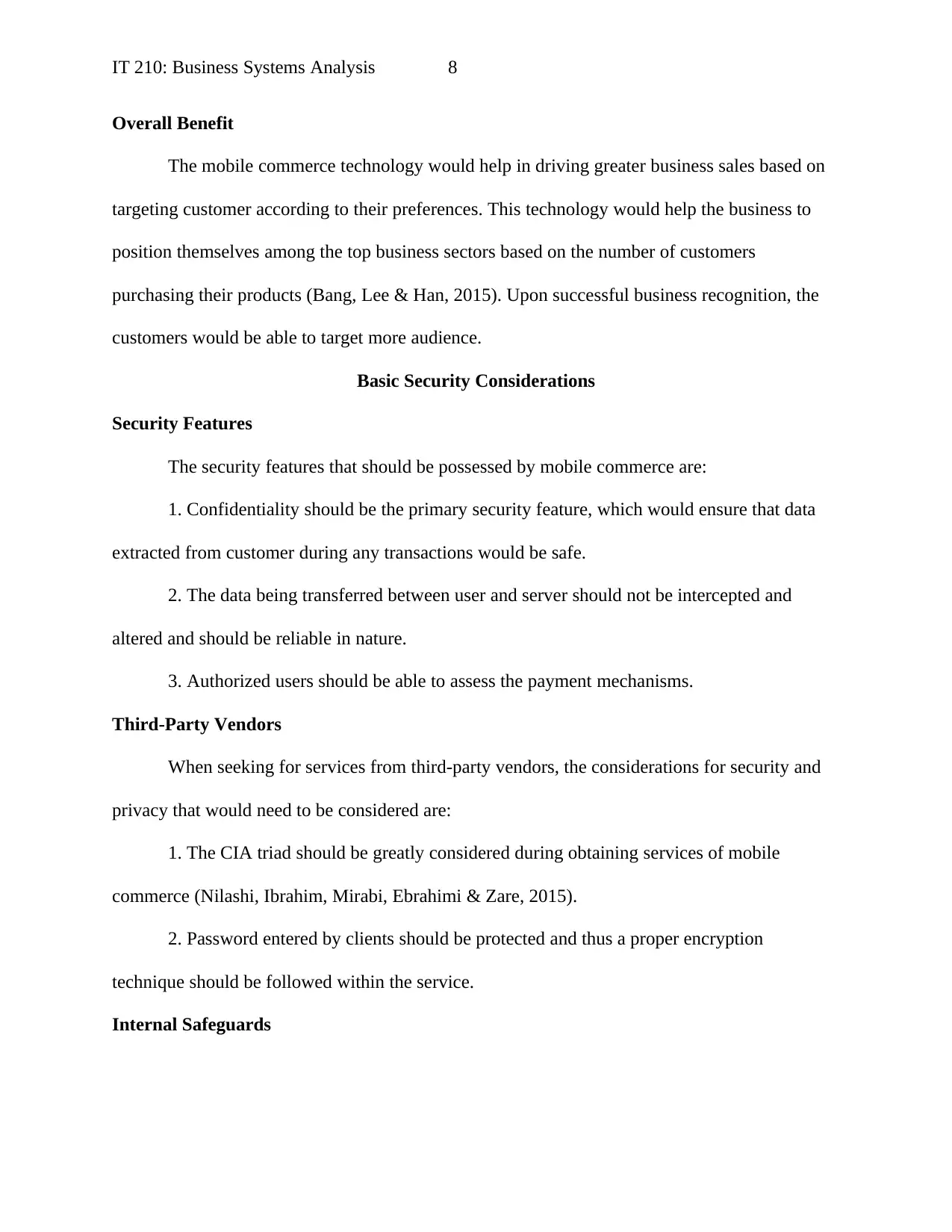
IT 210: Business Systems Analysis 8
Overall Benefit
The mobile commerce technology would help in driving greater business sales based on
targeting customer according to their preferences. This technology would help the business to
position themselves among the top business sectors based on the number of customers
purchasing their products (Bang, Lee & Han, 2015). Upon successful business recognition, the
customers would be able to target more audience.
Basic Security Considerations
Security Features
The security features that should be possessed by mobile commerce are:
1. Confidentiality should be the primary security feature, which would ensure that data
extracted from customer during any transactions would be safe.
2. The data being transferred between user and server should not be intercepted and
altered and should be reliable in nature.
3. Authorized users should be able to assess the payment mechanisms.
Third-Party Vendors
When seeking for services from third-party vendors, the considerations for security and
privacy that would need to be considered are:
1. The CIA triad should be greatly considered during obtaining services of mobile
commerce (Nilashi, Ibrahim, Mirabi, Ebrahimi & Zare, 2015).
2. Password entered by clients should be protected and thus a proper encryption
technique should be followed within the service.
Internal Safeguards
Overall Benefit
The mobile commerce technology would help in driving greater business sales based on
targeting customer according to their preferences. This technology would help the business to
position themselves among the top business sectors based on the number of customers
purchasing their products (Bang, Lee & Han, 2015). Upon successful business recognition, the
customers would be able to target more audience.
Basic Security Considerations
Security Features
The security features that should be possessed by mobile commerce are:
1. Confidentiality should be the primary security feature, which would ensure that data
extracted from customer during any transactions would be safe.
2. The data being transferred between user and server should not be intercepted and
altered and should be reliable in nature.
3. Authorized users should be able to assess the payment mechanisms.
Third-Party Vendors
When seeking for services from third-party vendors, the considerations for security and
privacy that would need to be considered are:
1. The CIA triad should be greatly considered during obtaining services of mobile
commerce (Nilashi, Ibrahim, Mirabi, Ebrahimi & Zare, 2015).
2. Password entered by clients should be protected and thus a proper encryption
technique should be followed within the service.
Internal Safeguards
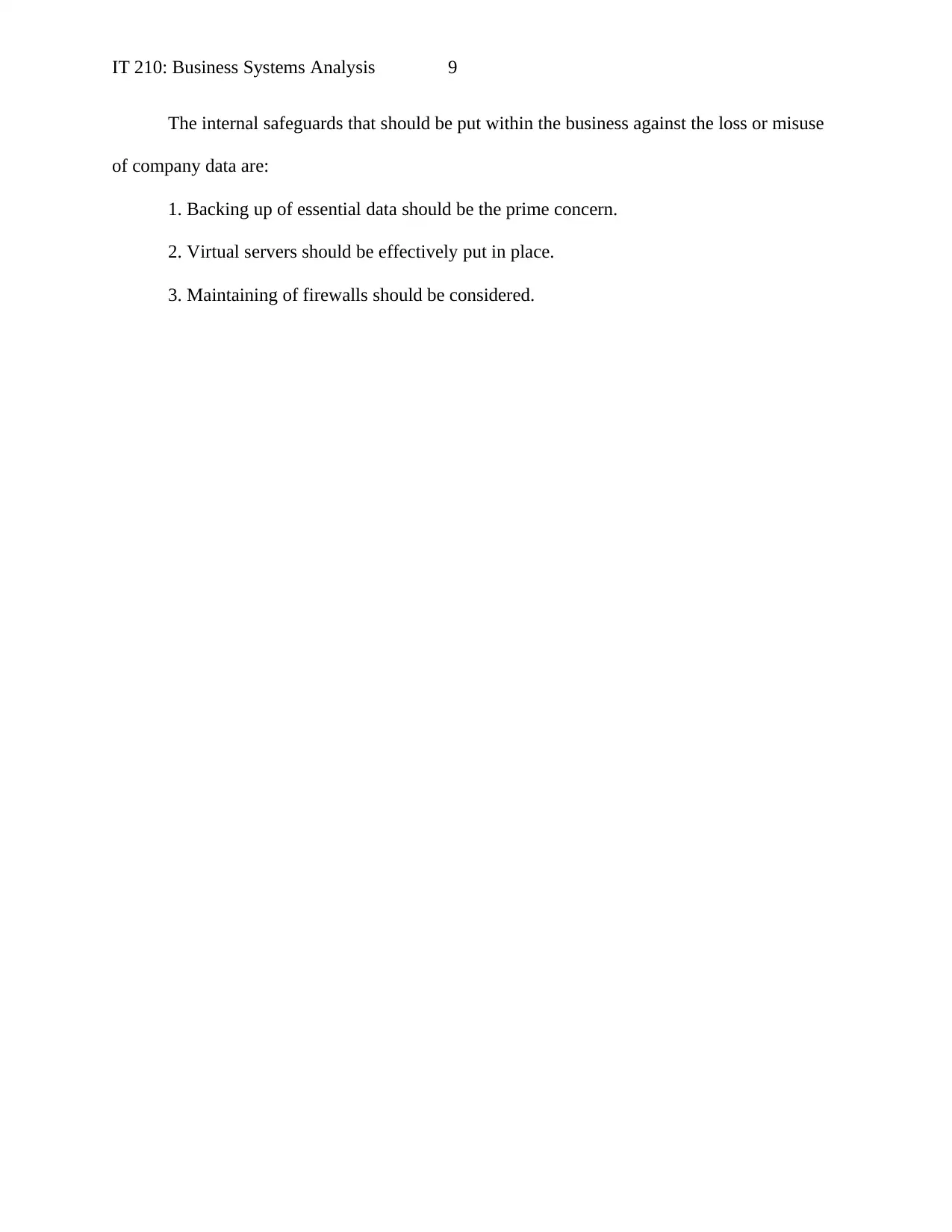
IT 210: Business Systems Analysis 9
The internal safeguards that should be put within the business against the loss or misuse
of company data are:
1. Backing up of essential data should be the prime concern.
2. Virtual servers should be effectively put in place.
3. Maintaining of firewalls should be considered.
The internal safeguards that should be put within the business against the loss or misuse
of company data are:
1. Backing up of essential data should be the prime concern.
2. Virtual servers should be effectively put in place.
3. Maintaining of firewalls should be considered.
⊘ This is a preview!⊘
Do you want full access?
Subscribe today to unlock all pages.

Trusted by 1+ million students worldwide
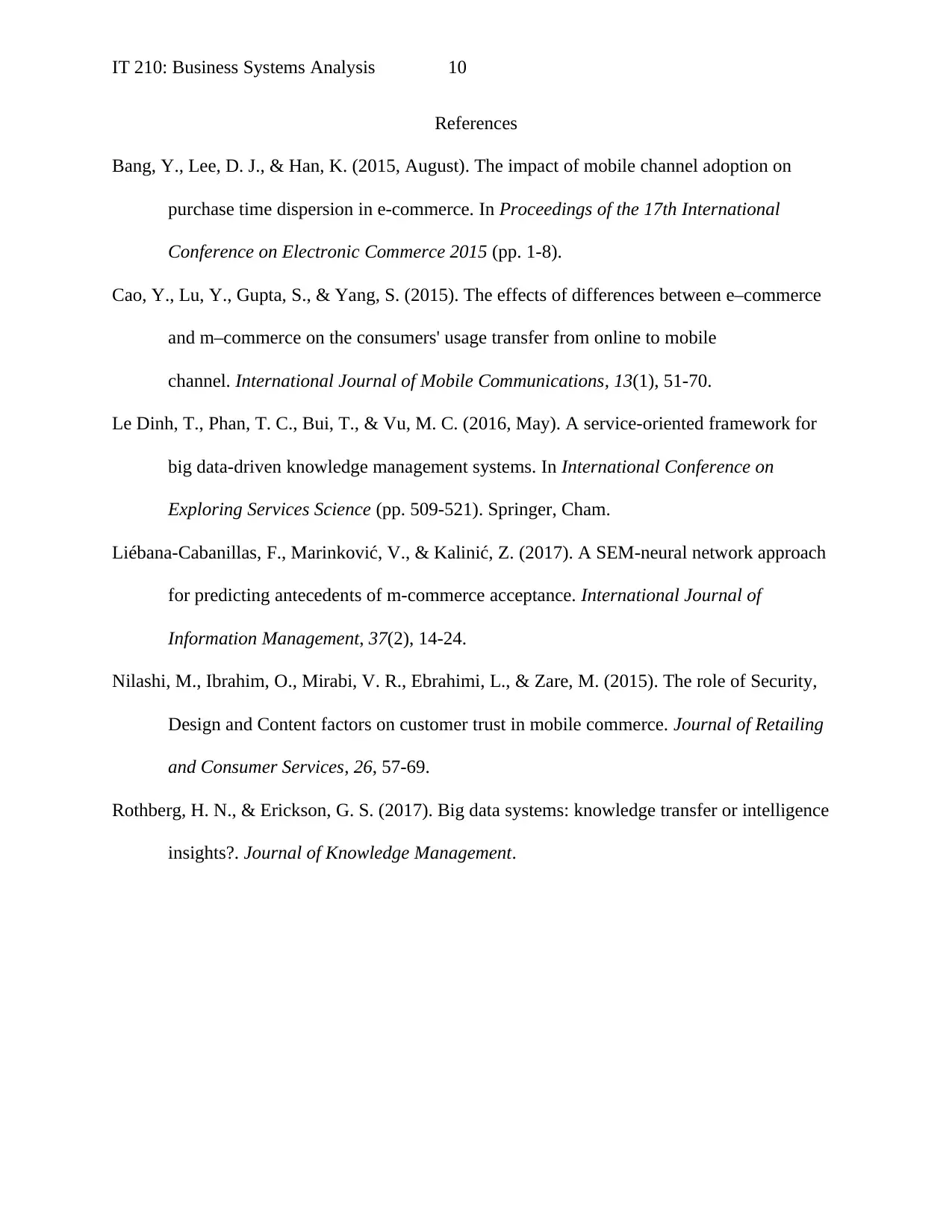
IT 210: Business Systems Analysis 10
References
Bang, Y., Lee, D. J., & Han, K. (2015, August). The impact of mobile channel adoption on
purchase time dispersion in e-commerce. In Proceedings of the 17th International
Conference on Electronic Commerce 2015 (pp. 1-8).
Cao, Y., Lu, Y., Gupta, S., & Yang, S. (2015). The effects of differences between e–commerce
and m–commerce on the consumers' usage transfer from online to mobile
channel. International Journal of Mobile Communications, 13(1), 51-70.
Le Dinh, T., Phan, T. C., Bui, T., & Vu, M. C. (2016, May). A service-oriented framework for
big data-driven knowledge management systems. In International Conference on
Exploring Services Science (pp. 509-521). Springer, Cham.
Liébana-Cabanillas, F., Marinković, V., & Kalinić, Z. (2017). A SEM-neural network approach
for predicting antecedents of m-commerce acceptance. International Journal of
Information Management, 37(2), 14-24.
Nilashi, M., Ibrahim, O., Mirabi, V. R., Ebrahimi, L., & Zare, M. (2015). The role of Security,
Design and Content factors on customer trust in mobile commerce. Journal of Retailing
and Consumer Services, 26, 57-69.
Rothberg, H. N., & Erickson, G. S. (2017). Big data systems: knowledge transfer or intelligence
insights?. Journal of Knowledge Management.
References
Bang, Y., Lee, D. J., & Han, K. (2015, August). The impact of mobile channel adoption on
purchase time dispersion in e-commerce. In Proceedings of the 17th International
Conference on Electronic Commerce 2015 (pp. 1-8).
Cao, Y., Lu, Y., Gupta, S., & Yang, S. (2015). The effects of differences between e–commerce
and m–commerce on the consumers' usage transfer from online to mobile
channel. International Journal of Mobile Communications, 13(1), 51-70.
Le Dinh, T., Phan, T. C., Bui, T., & Vu, M. C. (2016, May). A service-oriented framework for
big data-driven knowledge management systems. In International Conference on
Exploring Services Science (pp. 509-521). Springer, Cham.
Liébana-Cabanillas, F., Marinković, V., & Kalinić, Z. (2017). A SEM-neural network approach
for predicting antecedents of m-commerce acceptance. International Journal of
Information Management, 37(2), 14-24.
Nilashi, M., Ibrahim, O., Mirabi, V. R., Ebrahimi, L., & Zare, M. (2015). The role of Security,
Design and Content factors on customer trust in mobile commerce. Journal of Retailing
and Consumer Services, 26, 57-69.
Rothberg, H. N., & Erickson, G. S. (2017). Big data systems: knowledge transfer or intelligence
insights?. Journal of Knowledge Management.
Paraphrase This Document
Need a fresh take? Get an instant paraphrase of this document with our AI Paraphraser
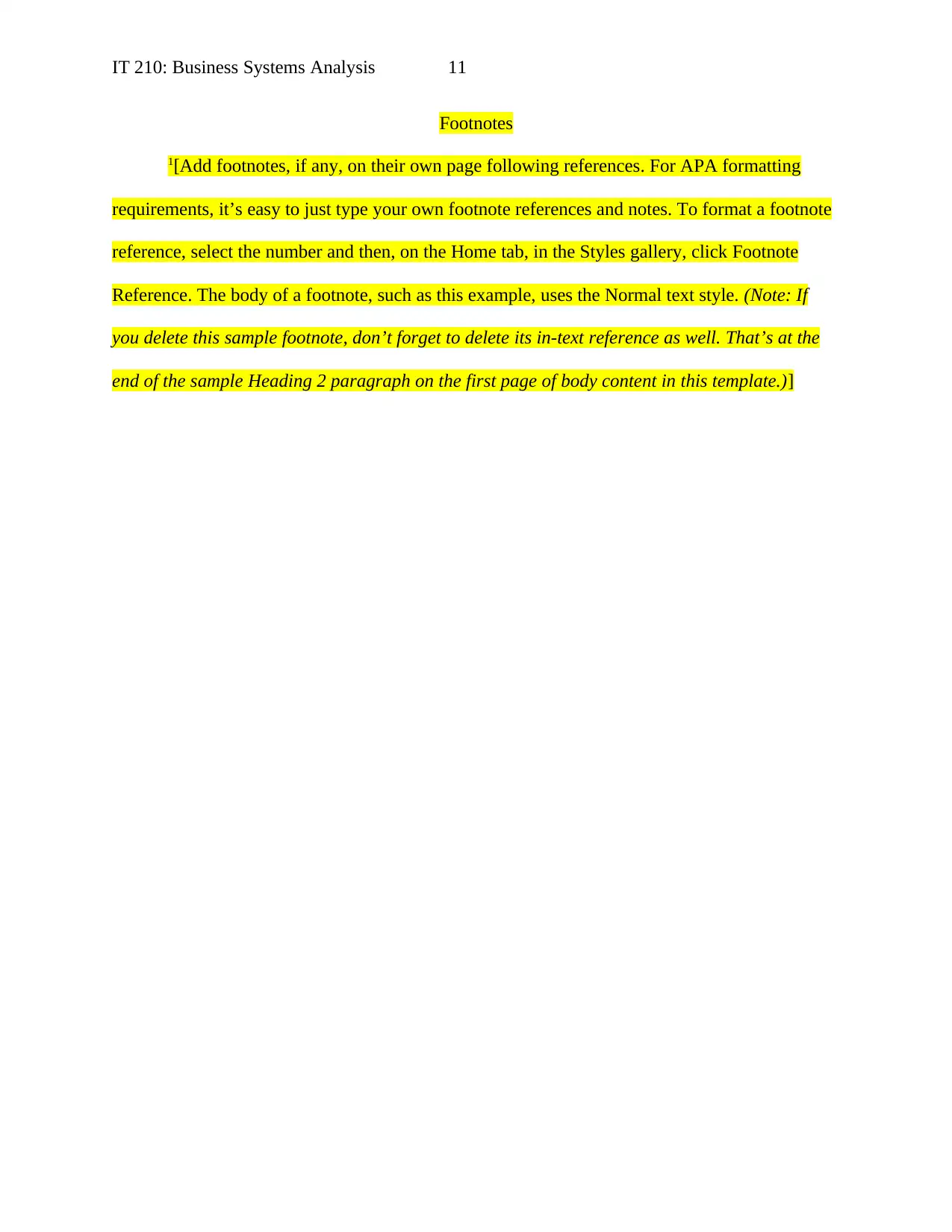
IT 210: Business Systems Analysis 11
Footnotes
1[Add footnotes, if any, on their own page following references. For APA formatting
requirements, it’s easy to just type your own footnote references and notes. To format a footnote
reference, select the number and then, on the Home tab, in the Styles gallery, click Footnote
Reference. The body of a footnote, such as this example, uses the Normal text style. (Note: If
you delete this sample footnote, don’t forget to delete its in-text reference as well. That’s at the
end of the sample Heading 2 paragraph on the first page of body content in this template.)]
Footnotes
1[Add footnotes, if any, on their own page following references. For APA formatting
requirements, it’s easy to just type your own footnote references and notes. To format a footnote
reference, select the number and then, on the Home tab, in the Styles gallery, click Footnote
Reference. The body of a footnote, such as this example, uses the Normal text style. (Note: If
you delete this sample footnote, don’t forget to delete its in-text reference as well. That’s at the
end of the sample Heading 2 paragraph on the first page of body content in this template.)]
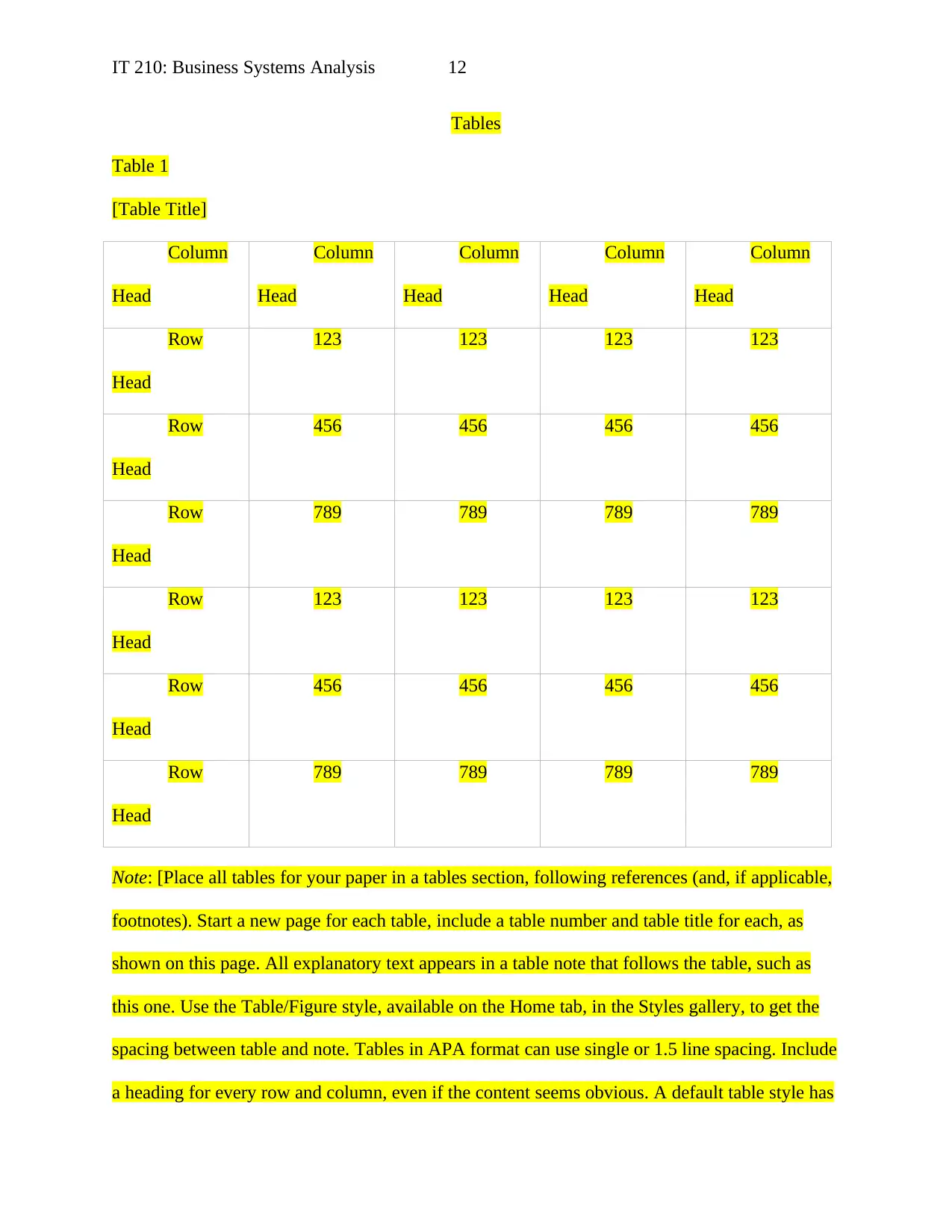
IT 210: Business Systems Analysis 12
Tables
Table 1
[Table Title]
Column
Head
Column
Head
Column
Head
Column
Head
Column
Head
Row
Head
123 123 123 123
Row
Head
456 456 456 456
Row
Head
789 789 789 789
Row
Head
123 123 123 123
Row
Head
456 456 456 456
Row
Head
789 789 789 789
Note: [Place all tables for your paper in a tables section, following references (and, if applicable,
footnotes). Start a new page for each table, include a table number and table title for each, as
shown on this page. All explanatory text appears in a table note that follows the table, such as
this one. Use the Table/Figure style, available on the Home tab, in the Styles gallery, to get the
spacing between table and note. Tables in APA format can use single or 1.5 line spacing. Include
a heading for every row and column, even if the content seems obvious. A default table style has
Tables
Table 1
[Table Title]
Column
Head
Column
Head
Column
Head
Column
Head
Column
Head
Row
Head
123 123 123 123
Row
Head
456 456 456 456
Row
Head
789 789 789 789
Row
Head
123 123 123 123
Row
Head
456 456 456 456
Row
Head
789 789 789 789
Note: [Place all tables for your paper in a tables section, following references (and, if applicable,
footnotes). Start a new page for each table, include a table number and table title for each, as
shown on this page. All explanatory text appears in a table note that follows the table, such as
this one. Use the Table/Figure style, available on the Home tab, in the Styles gallery, to get the
spacing between table and note. Tables in APA format can use single or 1.5 line spacing. Include
a heading for every row and column, even if the content seems obvious. A default table style has
⊘ This is a preview!⊘
Do you want full access?
Subscribe today to unlock all pages.

Trusted by 1+ million students worldwide
1 out of 14
Related Documents
Your All-in-One AI-Powered Toolkit for Academic Success.
+13062052269
info@desklib.com
Available 24*7 on WhatsApp / Email
![[object Object]](/_next/static/media/star-bottom.7253800d.svg)
Unlock your academic potential
Copyright © 2020–2025 A2Z Services. All Rights Reserved. Developed and managed by ZUCOL.




